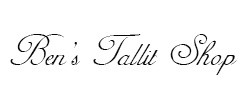Many of our customers are not sure what the neck band of the tallit should look like, sometimes asking whether it needs the blessing embroidered on it. Here's a recent inquiry:
I noticed that many of the tallits you sell don't have the prayer on the tallit. Isn't there an option on your website to add it? I want to be sure it's kosher so my son can use it for his bar mitzvah. - Aaron D.
I explained to Aaron that what he's referring to is not actually a prayer, but the Tzitzit Blessing. If you take a look at tallits from your grandfather's generation you'll find that almost none have any lettering on the atara (neckband).
The bracha is printed in every siddur at the beginning of the morning service. People who put on a tallit every day read the bracha from the siddur for about a week or two, and then they say it from memory. Therefore if you go to a congregation with a daily minyan, you'll see that most tallits don't have an atara with the blessing -- because they don't need it.
Today, the vast majority of traditional high-end tallits have a fairly plain white-on-white atara that looks like this. If you go to the Mishkan Hatchelet or Talitania website (they are the two leading tallit makers worldwide), the high-end traditional tallits have a plain atara, while the more modern, colorful tallits usually (but not always) have the type of atara with the bracha. In fact, here, too, the more expensive modern tallits like the Bareket and Sapir are colorful, but have an atara without the bracha.
Not kosher? Of course it's kosher! In fact, it's more kosher without the bracha. For one, the Shulchan Aruch says a tallit should not have lettering, but allows it as a leniency. Secondly, to don a tallit properly, you should have the tallit held up behind you above your shoulders when you recite the bracha, not held in front of you. I could provide you with citations if you'd be interested. We wrote about this very topic on our blog seven years ago. To refer to the post, click here. For corroboration, see this short Q&A on the Ohr Somayach website.
Why don't we at least offer it as an option? Let me explain why we don't: We sell hand-woven tallits made by two different tallit makers, Gabrieli and Weaving Creation. Periodically we used to get requests from customers who were thinking of ordering a Gabrieli tallit, but, like Aaron, were expecting to have the atara. I sometimes tried to dissuade them, explaining that the mass-produced synthetic ataras with the bracha are way below the level of the rest of the tallit, which has a very unique weave. We could easily go ahead and sew on this type of atara, but for our customers' sake we avoid it. In fact, it would be quite profitable for us to switch. Notice that this atara is priced at $7.50, while a hand-woven atara, like the one on the tallit we sent you, is priced at $50!
About six months ago Gabrieli came out with a new line they called Gabrieli Premium. One of the features that distinguish these tallits from the standard Gabrieli line is that they have a nice hand-woven atara that does include the Tzitzit Blessing. This is a major innovation. Gabrieli made tallits for close to four decades before they introduced that. And the price is a bit prohibitive.
------------
Update: We now offer an option on every Gabrieli product page to have an atara with the blessing (instead of striping only).
 United States Dollar
United States Dollar
 Shekel
Shekel
 Euro
Euro
 British Pound
British Pound
 Australian Dollar
Australian Dollar
 New Zealand Dollar
New Zealand Dollar
 Canadian Dollar
Canadian Dollar
